Analysis Application of Controllable Load Appliances Management in a Smart Home
Abstract
:1. Introduction
1.1. Framework and the State-of-the-Art
1.2. Benefits and Risks of a Smart House and Demand Response Concept
- Confidentiality—the guarantee that the data will be disclosed only to authorized entities or systems. This means that only authorized people are allowed to access certain information;
- Integrity—the guarantee that the accuracy and consistency of the data will be maintained. No unauthorized modifications, destruction, or losses of data will go undetected;
- Availability—the assurance that any network resource (data/bandwidth/equipment) will always be available for any authorized entity. Such resources have to also be protected against any incident that threatens their availability;
- Authenticity and authorization—the validation that communicating parties are, who they claim they are, and that messages supposedly sent by them are indeed sent by them;
- Non repudiation—undeniable proof to verify the truthfulness of any claim of an entity [21]. In order to minimize the energy costs, the SHs have programs that help users to reduce their expenses. These programs are called demand response (DR) programs.
1.3. Related Works Considering Management of Controllable Appliances in a Smart Home
1.4. Goals, Contributions and Structure
- The evaluation of the load distribution of the SWH for each tariff under analysis;
- The evaluation of the load distribution of the HVAC system, in cooling mode, for each tariff;
- The evaluation of the cost/profit associated for each tariff (flat price, TOU, RTP, and CPP schemes).
2. Mathematical Formulation
2.1. Objetive Function and Market Pricing Modelling
2.2. Sanitary Water Heating Load Model
2.3. Heating, Ventilation and Air Conditioning Load Model
3. Case Study and Results Analysis
3.1. Details, Data, and System Considered
3.2. Analysis Results
3.3. Cases Comparison Overview and Discussion
3.3.1. Comparison and Discussion between Cases 2, 3, and 4
3.3.2. Comparison and Discussion between Case 1 and Case 4: The Best Case
4. Conclusions
5. Future Research
Author Contributions
Funding
Conflicts of Interest
Nomenclature
| Smart house rooftop angle (deg). | |
| Sanitarian water heater capacitance (kWh/). | |
| Thermal capacity of air (kJ/kg). | |
| Heating, ventilation, and air conditioning system performance coefficient ( Summer; Winter). | |
| Electricity price cost (buying) in the real-time market (€/kWh). | |
| Duration of the time interval (h). | |
| Day-ahead market electricity price (€/kWh). | |
| Sold electricity price in the real-time market (€/kWh). | |
| Expected profit (€). | |
| Battery-based energy storage system efficiency. | |
| Size dimensions of the smart house, length, width, height (m). | |
| Predicted energy value of the heating, ventilation and air conditioning system in the day-ahead market (kWh). | |
| Energy consumption of the heating, ventilation, and air conditioning system in the real-time market (kWh). | |
| Predicted energy value of the most run services in the day-ahead market (kWh). | |
| Energy consumption of the most-run services in the real-time market (kWh). | |
| Predicted energy value of the sanitarian water heating system in the day-ahead market (kWh). | |
| Energy consumption of the sanitarian water heating system in the real-time market (kWh). | |
| Sanitarian water heater tank capacity (). | |
| Volume of the smart house (m3). | |
| Hot water usage from the sanitarian water heater (). | |
| Rated power of the heating, ventilation, and air conditioning system (kW). | |
| Probability of the wind power scenario. | |
| Charging energy of the electric vehicle in the day-ahead market (kWh). | |
| Discharging energy from the electric vehicle in the day-ahead market (kWh). | |
| Traded energy with the day-ahead market (kWh). | |
| Energy traded in the day-ahead market in the day-ahead market (kWh). | |
| Sold energy in the day-ahead market (kWh). | |
| Power for each time slot from the sanitarian water heater (kW). | |
| Charging energy of the battery-based energy storage system in the day-ahead market (kWh). | |
| Charging energy of the battery-based energy storage system in the real-time market (kWh). | |
| Battery-based energy storage system discharging in the real-time market (kWh). | |
| Charging energy of the electric vehicle in the real-time market (kWh). | |
| Discharged energy from the electric vehicle in the real-time market (kWh). | |
| Wind power point forecast in the day-ahead market (kW). | |
| Energy consumed in the day-ahead market (kWh). | |
| Energy bought in the real-time market (kWh). | |
| Energy sold in the real-time market (kWh). | |
| Wind power spillage in the real-time market (kW). | |
| Sanitarian water heater power (kWh). | |
| Sanitarian water heater resistivity (/kWh). | |
| Equivalent resistance of the heating, ventilation and air conditioning system (). | |
| Smart house environment temperature set-point (). | |
| Smart house environment temperature deviation (). | |
| Available wind power at time at scenario . (kW) | |
| Time-step period (); . | |
| Minimum permanent hot water temperature in the sanitarian water heater (). | |
| Maximum permanent hot water temperature in the sanitarian water heater (). | |
| Minimum hot water temperature for the showering process (). | |
| Temperature of the sanitarian water heater tank (). | |
| Outdoor environment temperature (). | |
| Inlet hot water temperature in the sanitarian water heater (). | |
| Smart house environment temperature. | |
| Auxiliary binary variable for the heating, ventilation, and air conditioning system status (). | |
| Auxiliary binary variable for the sanitarian water heater status (). | |
| Spillage cost of the wind system (€). | |
| Wind power scenario index (); . |
Abbreviations
| CPP | Critical-peak pricing. |
| DR | Demand response. |
| EC | Expected cost. |
| EP | Expected profit. |
| ESS | Energy storage system. |
| EU | European Union. |
| EV | Electric vehicle. |
| G2V | Grid to vehicle. |
| HEM | Home energy management systems. |
| HVAC | Heating, ventilation and air conditioning. |
| IBDR | Demand response-based on incentives. |
| PBDR | Demand response-based on prices. |
| RC | Residential customer. |
| RTP | Real-time pricing. |
| RTP | Real-time pricing. |
| SG | Smart grids. |
| SH | Smart house. |
| SWH | Sanitarian water heater. |
| TOU | Time-of-use. |
| V2G | Vehicle to grid. |
References
- Le Ray, G.; Larsen, E.M.; Pinson, P. Evaluating price-based demand response in practice—with application to the ecogrid EU experiment. IEEE Trans. Smart Grid 2018, 9, 2304–2313. [Google Scholar] [CrossRef]
- Kim, J. HEMS (home energy management system) base on the IoT smart home. Contemp. Eng. Sci. 2016, 9, 21–28. [Google Scholar] [CrossRef]
- Bhati, A.; Hansen, M.; Man Chan, C. Energy conservation through smart homes in a smart city: A lesson for Singapore households. Energy Policy 2017, 104, 230–239. [Google Scholar] [CrossRef]
- Marakova, A. Smart House. Master’s Thesis, Czech Technical University in Prague, Praha, Zikova, 2015. Available online: https://dspace.cvut.cz/bitstream/handle/10467/62043/F3-DP-2015-Makarova-Anastasiia (accessed on 28 August 2019).
- Use Case: Smart Home. Trusted Objects. Available online: http://trusted-objects.com/webtest/smart-home (accessed on 8 January 2019).
- Hong, X.; Yang, C.; Rong, C. Smart home security monitor system. In Proceedings of the 15th International Symposium on Parallel and Distributed Computing (ISPDC), FuZhou, China, 8–10 July 2016; pp. 247–251. [Google Scholar]
- Benyoucef, D.; Klein, P.; Bier, T. Smart meter with non-intrusive load monitoring for use in smart homes. In Proceedings of the 2010 IEEE International Energy Conference, Manama, Bahrain, 6–9 December 2010; pp. 96–101. [Google Scholar] [CrossRef]
- Pilich, B. Engineering Smart Houses. Master’s Thesis, Technical University of Denmark, Lyngby, Denmark, 2004. Available online: http://www2.imm.dtu.dk/pubdb/ (accessed on 8 January 2019).
- Amer, M.; Naaman, A.; M’Sirdi, N.K.; El-Zonkoly, A.M. A hardware algorithm for PAR reduction in smart home. In Proceedings of the International Conference on Applied and Theoretical Electricity (ICATE), Craiova, Romania, 23–25 October 2014; pp. 1–6. [Google Scholar]
- Shao, S.; Pipattanasomporn, M.; Rahman, S. Development of physical-based demand response enabled residential load models. IEEE Trans. Power Syst. 2013, 28, 607–614. [Google Scholar] [CrossRef]
- Yu, Z.; Li, S.; Tong, L. On market dynamics of electric vehicle diffusion. In In Proceedings of the 52nd Annual Allerton Conference on Communication, Control, and Computing (Allerton), Monticello, IL, USA, 30 September–3 October 2014; pp. 1051–1057. [Google Scholar] [CrossRef]
- He, Y.; Venkatesh, B.; Guan, L. Optimal scheduling for charging and discharging of electric vehicles. IEEE Trans. Smart Grid 2012, 3, 1095–1105. [Google Scholar] [CrossRef]
- Gago, R.G.; Pinto, S.F.; Silva, J.F. G2V and V2G electric vehicle charger for smart grids. In Proceedings of the IEEE International Smart Cities Conference (ISC2), Trento, Italy, 14–17 October 2016; pp. 1–6. [Google Scholar] [CrossRef]
- Vasudevan, J.; Swarup, K.S. Price based demand response strategy considering load priorities. In Proceedings of the IEEE 6th International Conference on Power Systems (ICPS), New Delhi, India, 4–6 March 2016; pp. 1–6. [Google Scholar] [CrossRef]
- Vlot, M.C.; Knigge, J.D.; Slootweg, J.G. Economical regulation power through load shifting with smart energy appliances. IEEE Trans. Smart Grid 2013, 4, 1705–1712. [Google Scholar] [CrossRef]
- Lai, J.; Zhou, H.; Hu, W.; Zhou, D.; Zhong, L. Smart demand response based on smart homes. Math. Probl. Eng. 2015, 912535, 1–8. [Google Scholar] [CrossRef]
- Tejani, D.; Al-Kuwari, A.M.A.H.; Potdar, V. Energy conservation in a smart home. In Proceedings of the 5th IEEE International Conference on Digital Ecosystems and Technologies (IEEE DEST), Daejeon, Korea, 31 May–3 June 2011; pp. 241–246. [Google Scholar] [CrossRef]
- Wilson, C.; Hargreaves, T.; Hauxwell-Baldwin, R. Benefits and risks of smart home technologies. Energy Policy 2017, 103, 72–83. [Google Scholar] [CrossRef] [Green Version]
- Mageroski, A.; Alsadoon, A.; Prasad, P.W.C.; Pham, L.; Elchouemi, A. Impact of wireless communications technologies on elder people healthcare: Smart home in Australia. In Proceedings of the 13th International Joint Conference on Computer Science and Software Engineering (JCSSE), Khon Kaen, Thailand, 13–15 July 2016; pp. 1–6. [Google Scholar] [CrossRef]
- Jacobsson, A.; Boldt, M.; Carlsson, B. On the risk exposure of smart home automation systems. In Proceedings of the International Conference on Future Internet of Things and Cloud, Barcelona, Spain, 27–29 August 2014; pp. 183–190. [Google Scholar] [CrossRef]
- Komninos, N.; Philippou, E.; Pitsillides, A. Survey in smart grid and smart home security: Issues, challenges and countermeasures. IEEE Commun. Surv. Tutor. 2014, 16, 1933–1954. [Google Scholar] [CrossRef]
- Hajibandeh, N.; Shafie-khah, M.; Talari, S.; Dehghan, S.; Amjady, N.; Mariano, S.J.P.S.; Catalão, J.P.S. Demand response based operation model in electricity markets with high wind power penetration. IEEE Trans. Sustain. Energy 2019, 10, 918–930. [Google Scholar] [CrossRef]
- Murthy Balijepalli, V.S.K.; Pradhan, V.; Khaparde, S.A.; Shereef, R.M. Review of demand response under smart grid paradigm. In Proceedings of the 2011 IEEE PES Innovative Smart Grid Technologies-India (ISGT 2011-India), Kollam, Kerala, India, 1–4 December 2011; pp. 236–243. [Google Scholar] [CrossRef]
- Gadham, K.R.; Ghose, T. Importance of social welfare point for the analysis of demand response. In Proceedings of the First IEEE International Conference on Control, Measurement and Instrumentation (CMI), Kolkata, India, 8–10 January 2016; pp. 182–185. [Google Scholar] [CrossRef]
- Panapakidis, I.P.; Frantza, S.I.; Papagiannis, G.K. Implementation of price-based demand response programs through a load pattern clustering process. In In Proceedings of the IEEE MedPower, Athens, Greece, 2–5 November 2014; pp. 1–8. [Google Scholar] [CrossRef]
- Hussin, N.S.; Abdullah, M.P.; Ali, A.I.M.; Hassan, M.Y.; Hussin, F. Residential electricity time of use (ToU) pricing for Malaysia. In Proceedings of the IEEE Conference on Energy Conversion (CENCON), Johor Bahru, Malaysia, 13–14 October 2014; pp. 429–433. [Google Scholar] [CrossRef]
- Celebi, E.; Fuller, D. Time-of-use pricing in electricity markets under different market structures. IEEE Trans. Power Syst. 2012, 27, 1170–1181. [Google Scholar] [CrossRef]
- Newsham, G.R.; Bowker, B.G. The effect of utility time-varying pricing and load control strategies on residential summer peak electricity use: A review. Energy Policy 2010, 38, 3289–3296. [Google Scholar] [CrossRef] [Green Version]
- Shuhaibera, A.; Mashalb, I. Understanding users’ acceptance of smart homes. Technol. Soc. 2019, 58, 1–9. [Google Scholar] [CrossRef]
- Paterakis, N.G.; Erdinç, O.; Pappi, I.N.; Barkirtzis, A.G.; Catalão, J.P.S. Coordinated operation of a neighborhood of smart households comprising electric vehicles, energy storage and distributed generation. IEEE Trans. Smart Grid 2016, 7, 2736–2747. [Google Scholar] [CrossRef]
- Özkan, H.A. Appliance based control for home power management systems. Energy 2016, 114, 693–707. [Google Scholar] [CrossRef]
- Rastegar, M.; Fotuhi-Firuzabad, M.; Moeini-Aghtaie, M. Developing a two-level framework for residential energy management. IEEE Trans. Smart Grid 2018, 9, 1707–1717. [Google Scholar] [CrossRef]
- Gram-Hanssen, K.; Darby, S.J. “Home is where the smart is”? Evaluating smart home research and approaches against the concept of home. Energy Res. Soc. Sci. 2018, 37, 94–101. [Google Scholar] [CrossRef]
- Najafi-Ghalelou, A.; Nojavan, S.; Zare, K. Robust thermal and electrical management of smart home using information gap decision theory. Appl. Therm. Eng. 2018, 132, 221–232. [Google Scholar] [CrossRef]
- Ni, Z.; Das, A. A new incentive-based optimization scheme for residential community with financial trade-offs. IEEE Access 2018, 6, 57802–57813. [Google Scholar] [CrossRef]
- Zhu, H.; Gao, Y.; Hou, Y.; Wang, Z.; Feng, X. Real-time pricing considering different type of smart home appliances based on Markov decision process. Electr. Power Energy Syst. 2019, 107, 486–495. [Google Scholar] [CrossRef]
- Zhu, J.; Lin, Y.; Lei, W.; Liu, Y.; Tao, M. Optimal household appliances scheduling of multiple smart homes using an improved cooperative algorithm. Energy 2019, 171, 944–955. [Google Scholar] [CrossRef]
- Paudyal, P.; Ni, Z. Smart home energy optimization with incentives compensation from inconvenience for shifting electric appliances. Electr. Power Energy Systems 2019, 109, 652–660. [Google Scholar] [CrossRef]
- Pawar, P.; Vittal, P.K. Design and development of advanced smart energy management system integrated with IoT framework in smart grid environment. J. Energy Storage 2019, 25, 1–13. [Google Scholar] [CrossRef]
- Krejcar, O.; Maresova, P.; Selamat, A.; Melero, F.R.; Barakovic, S.; Husic, J.B.; Herrera-Viedma, E.; Frischer, R.; Kuca, A. Smart Furniture as a Component of a Smart City—Definition based on key technologies specification. IEEE Access 2019, 7, 94822–94839. [Google Scholar] [CrossRef]
- Lim, C.; Maglio, P.P. Data-driven understanding of smart service systems through text mining. Serv. Sci. 2018, 10, 154–180. [Google Scholar] [CrossRef]
- Al Essa, M.J.M. Home energy management of thermostatically controlled loads and photovoltaic-battery systems. Energy 2019, 176, 742–752. [Google Scholar] [CrossRef]
- Shafie-khah, M.; Siano, P. A Stochastic home energy management system considering satisfaction cost and response fatigue. IEEE Trans. Ind. Inf. 2018, 14, 629–638. [Google Scholar] [CrossRef]
- Nan, S.; Zhou, M.; Li, G. Optimal residential community demand response scheduling in smart grid. Appl. Energy 2018, 210, 1280–1289. [Google Scholar] [CrossRef]
- Paterakis, N.G.; Erdinç, O.; Barkirtzis, A.G.; Catalão, J.P.S. Optimal household appliances scheduling under day-ahead pricing and load-shaping demand response strategies. IEEE Trans. Ind. Inf. 2015, 11, 1509–1519. [Google Scholar] [CrossRef]
- General Algebraic Modeling System (GAMS). Available online: https://www.gams.com/ (accessed on 8 October 2018).
- Du, P.; Lu, N. Appliance commitment for household load scheduling. IEEE Trans. Smart Grid 2011, 2, 411–419. [Google Scholar] [CrossRef]


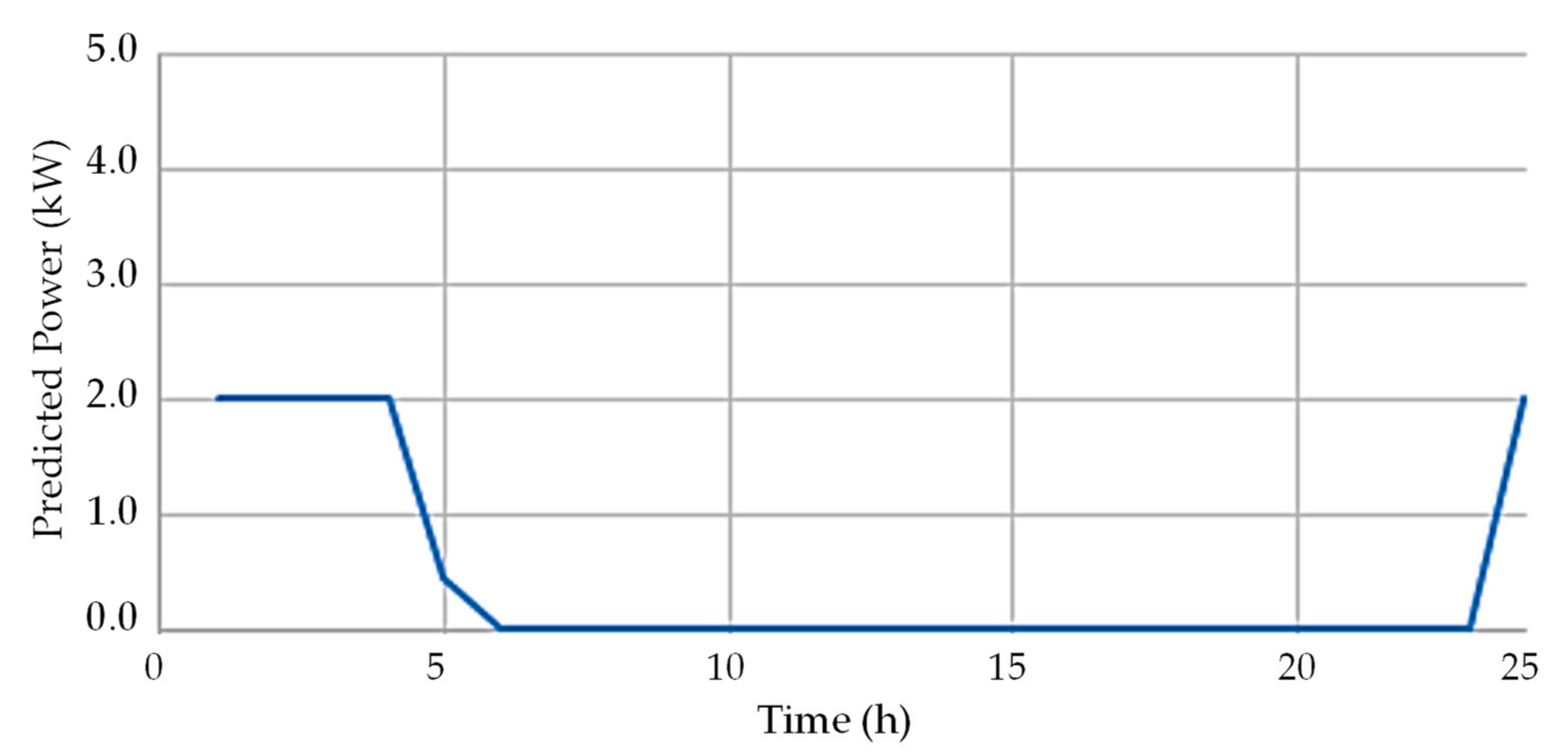
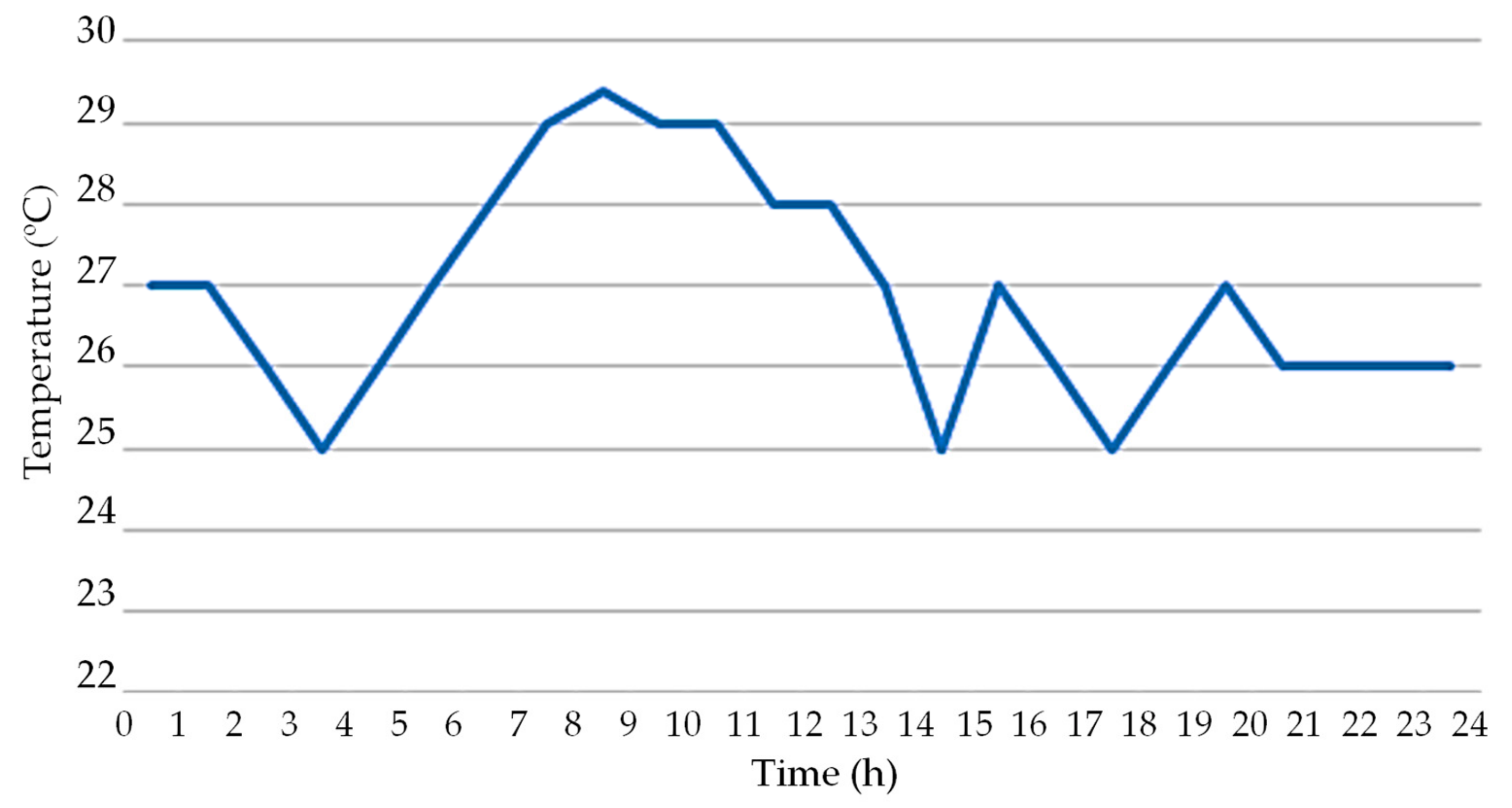

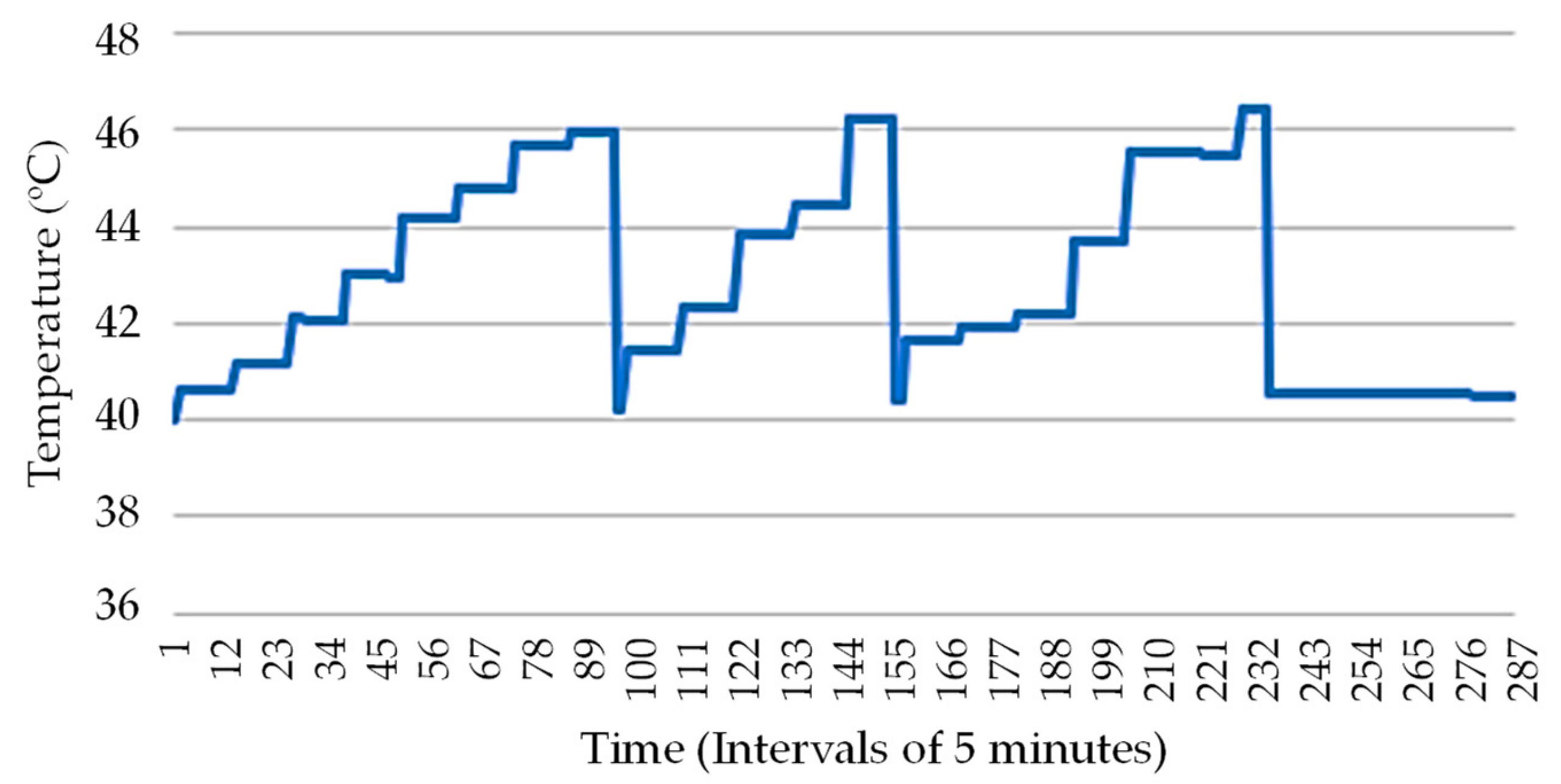
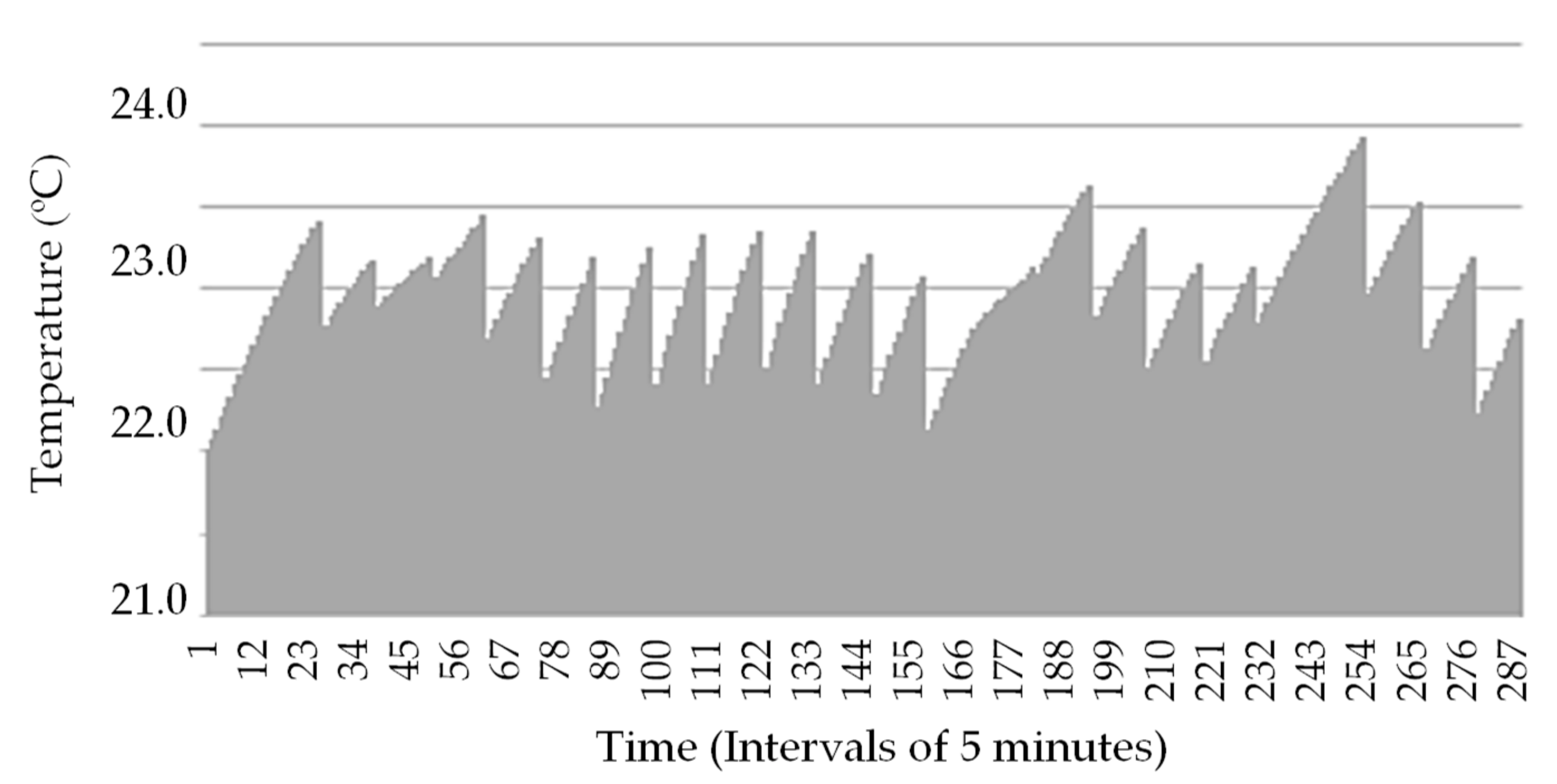
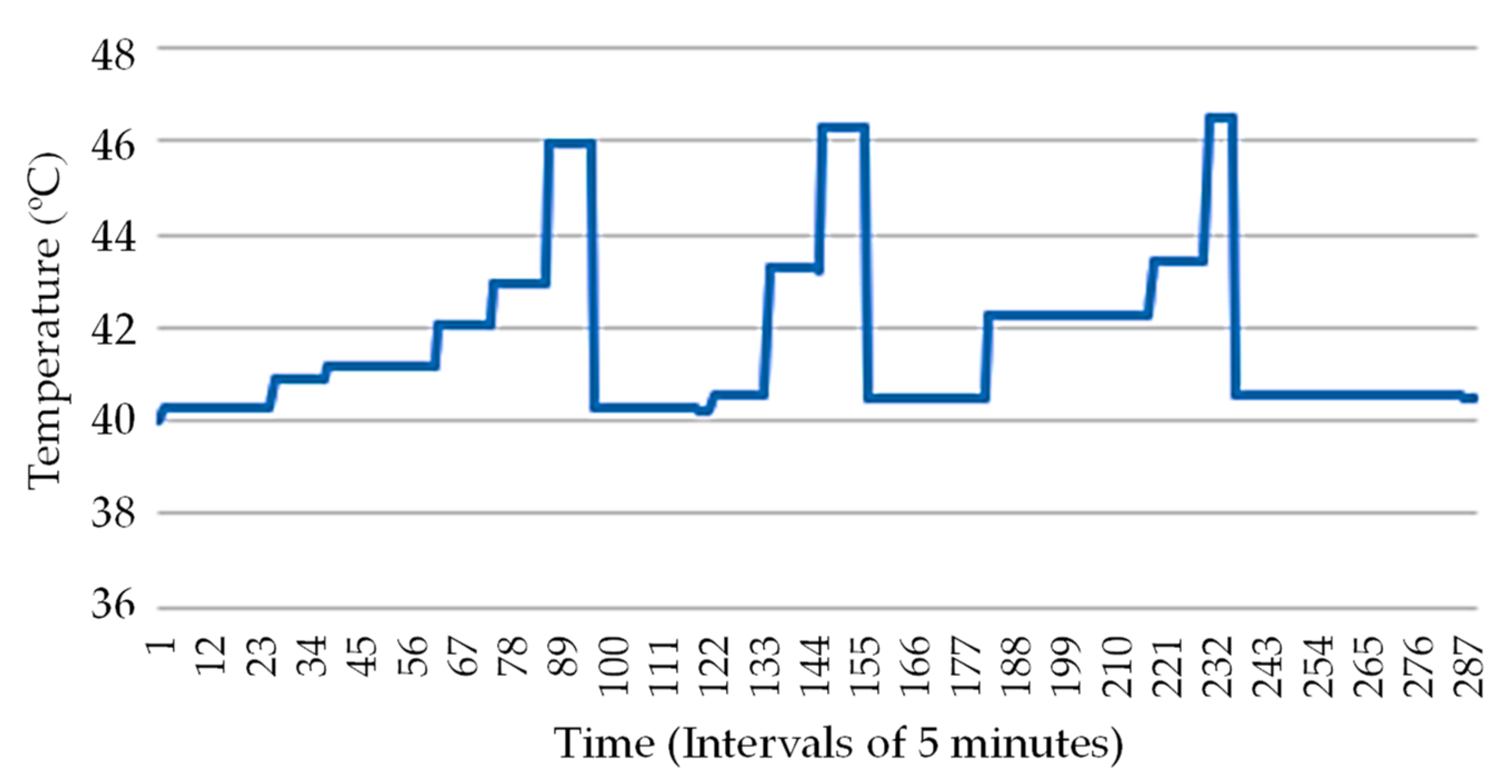
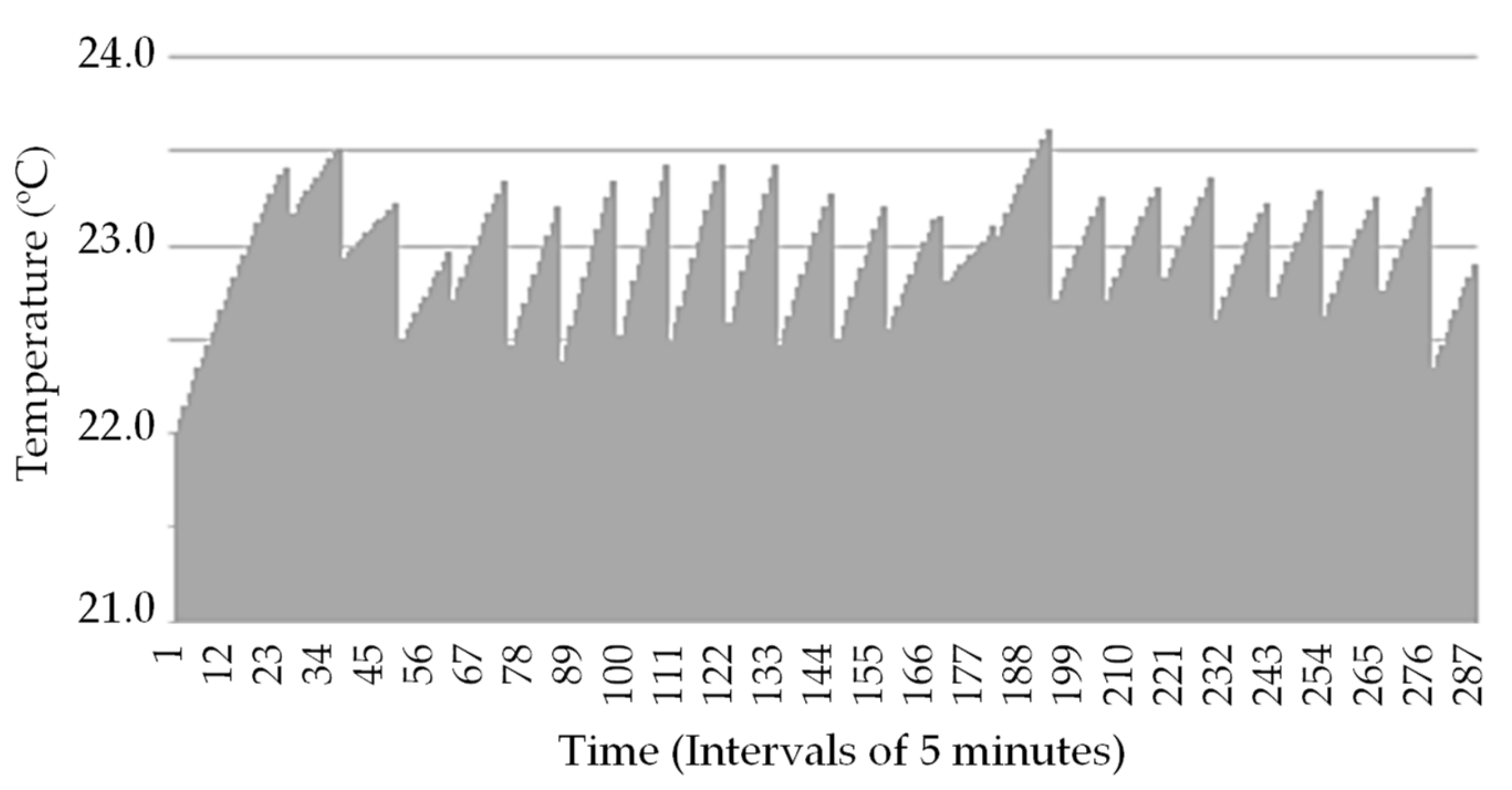
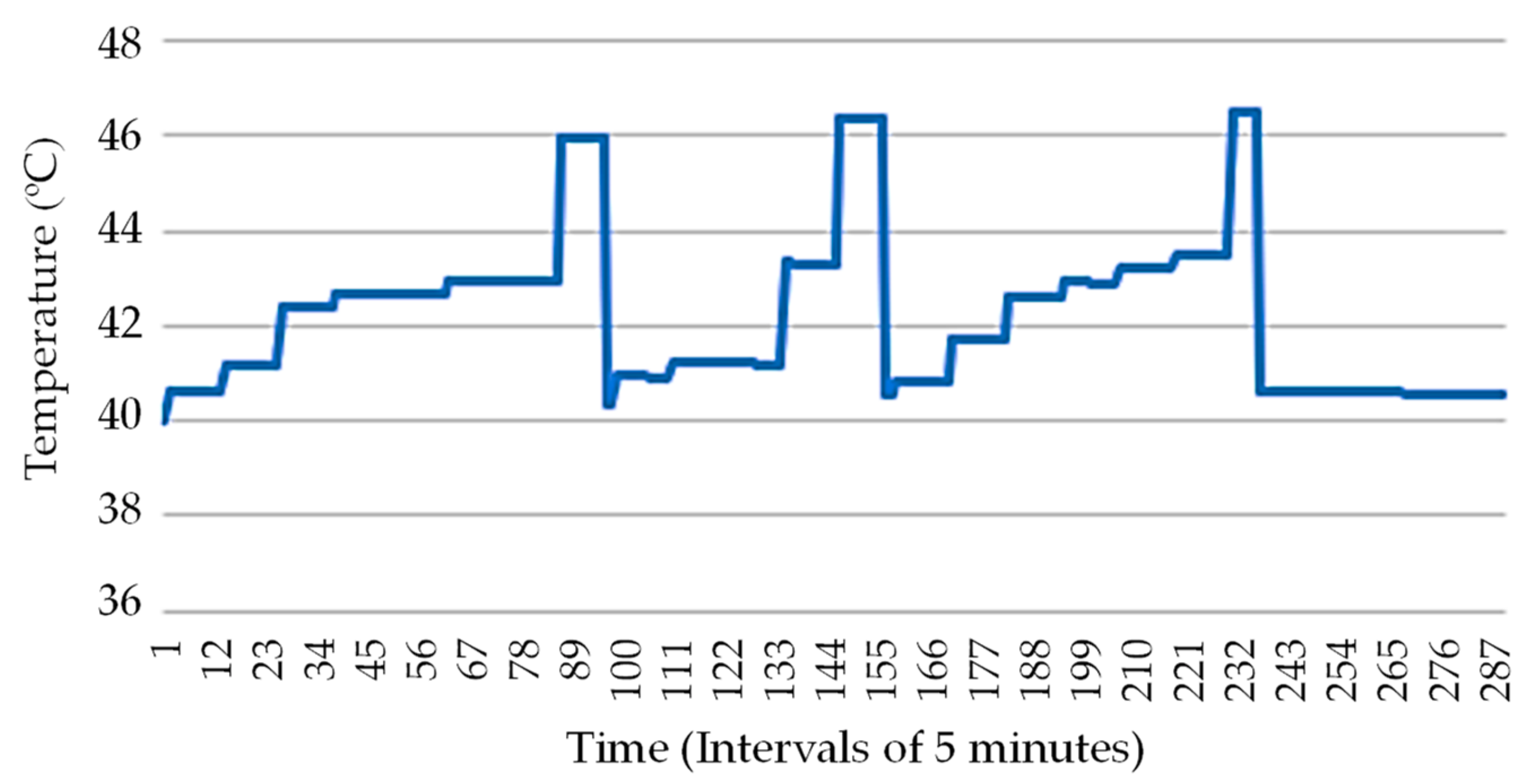

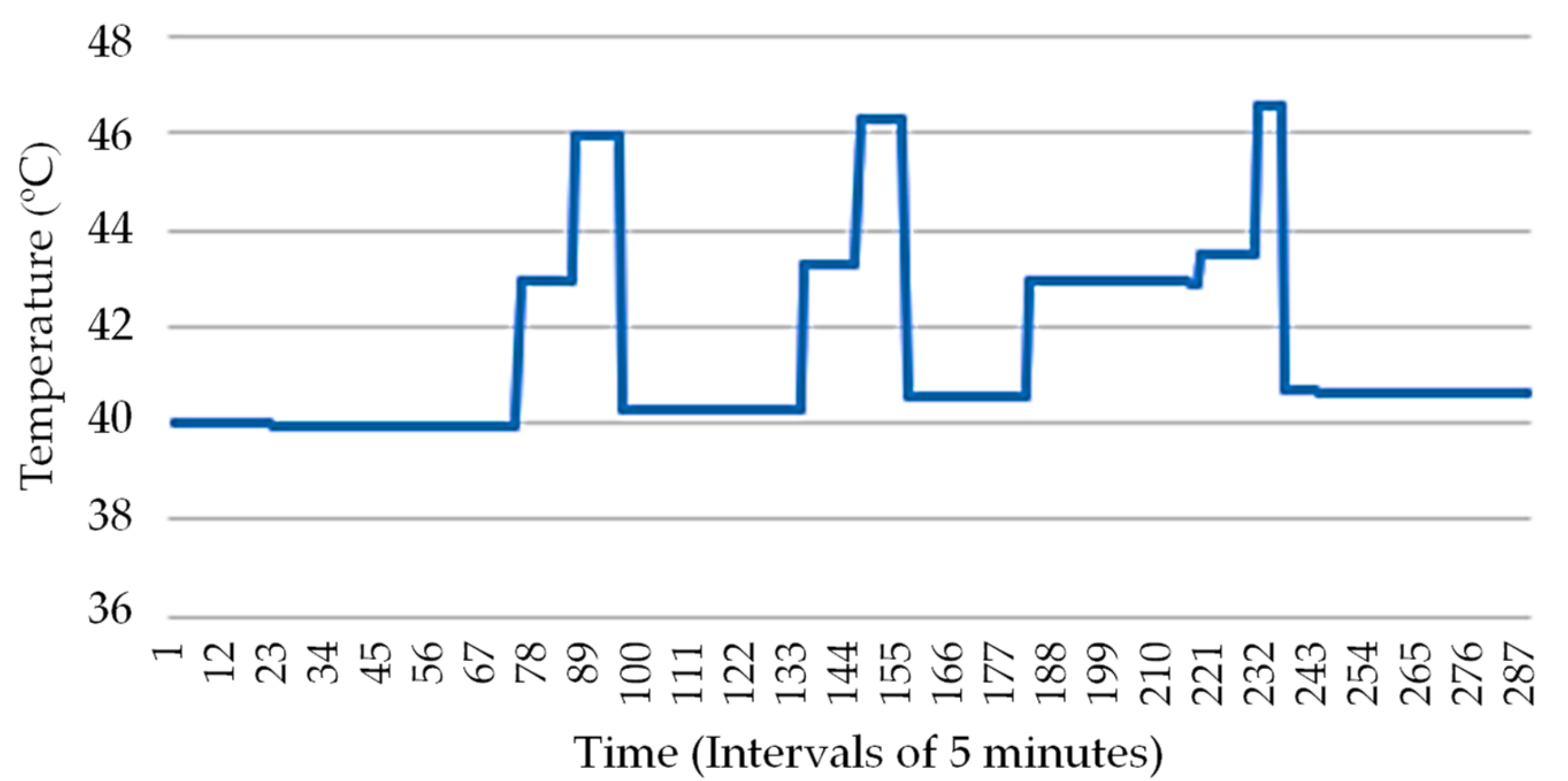
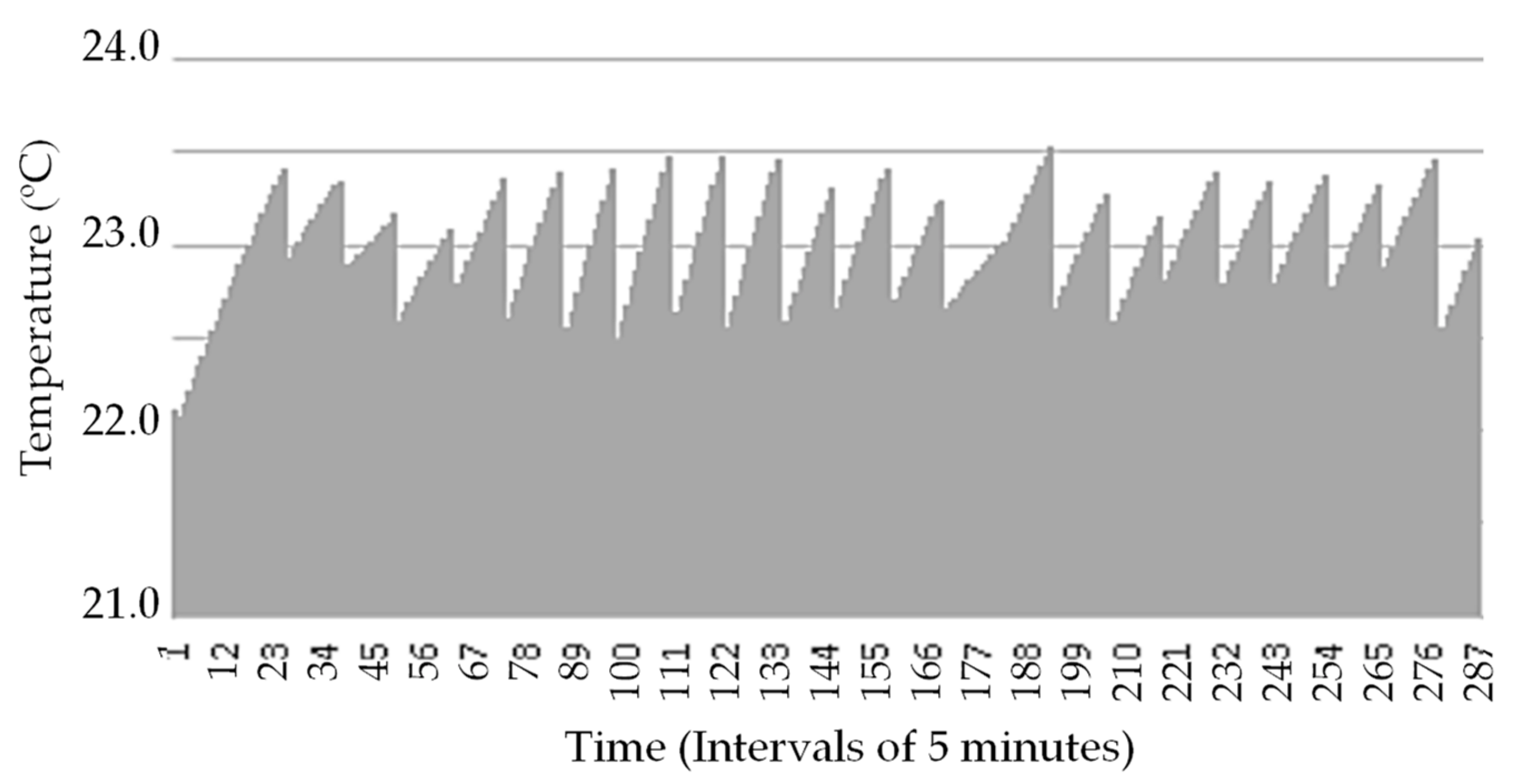


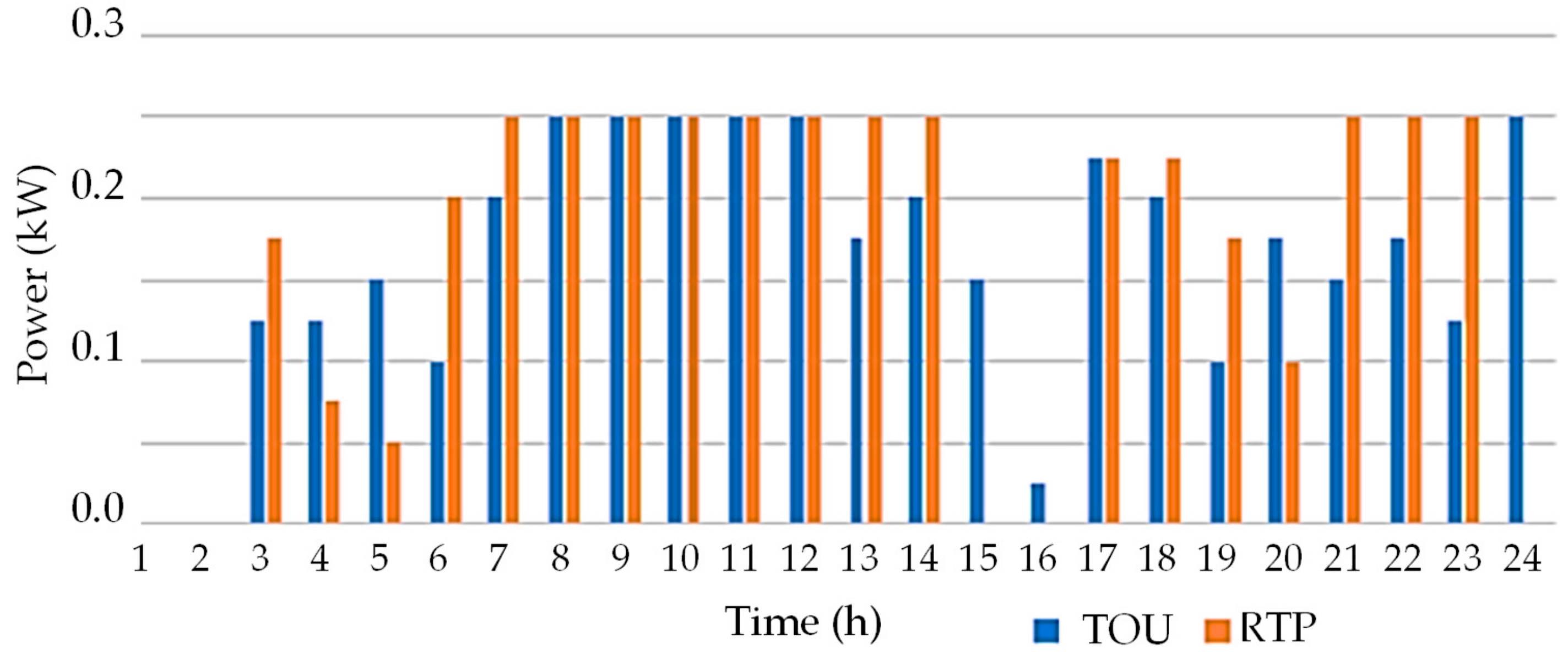
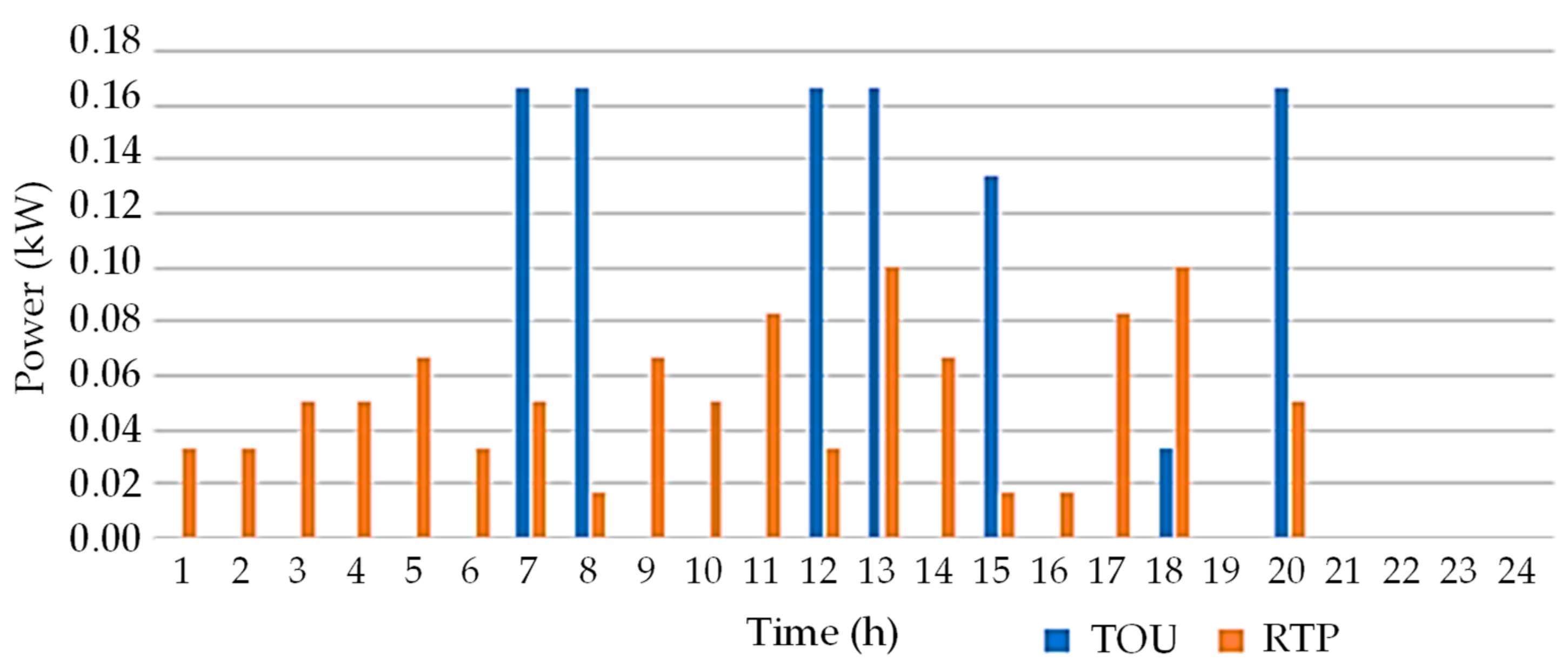
| Case | Tariff Scheme | Objective Function (€) |
|---|---|---|
| case 2 | CPP | 1.06 |
| case 3 | Flat price | 2.99 |
| case 4 | TOU | 4.89 |
| Case | Tariff Scheme | Objective Function (€) |
|---|---|---|
| case 1 | RTP | 0.45 |
| case 4 | TOU | 4.89 |
© 2019 by the authors. Licensee MDPI, Basel, Switzerland. This article is an open access article distributed under the terms and conditions of the Creative Commons Attribution (CC BY) license (http://creativecommons.org/licenses/by/4.0/).
Share and Cite
Osório, G.J.; Shafie-khah, M.; Carvalho, G.C.R.; Catalão, J.P.S. Analysis Application of Controllable Load Appliances Management in a Smart Home. Energies 2019, 12, 3710. https://doi.org/10.3390/en12193710
Osório GJ, Shafie-khah M, Carvalho GCR, Catalão JPS. Analysis Application of Controllable Load Appliances Management in a Smart Home. Energies. 2019; 12(19):3710. https://doi.org/10.3390/en12193710
Chicago/Turabian StyleOsório, Gerardo J., Miadreza Shafie-khah, Gonçalo C. R. Carvalho, and João P. S. Catalão. 2019. "Analysis Application of Controllable Load Appliances Management in a Smart Home" Energies 12, no. 19: 3710. https://doi.org/10.3390/en12193710
APA StyleOsório, G. J., Shafie-khah, M., Carvalho, G. C. R., & Catalão, J. P. S. (2019). Analysis Application of Controllable Load Appliances Management in a Smart Home. Energies, 12(19), 3710. https://doi.org/10.3390/en12193710







